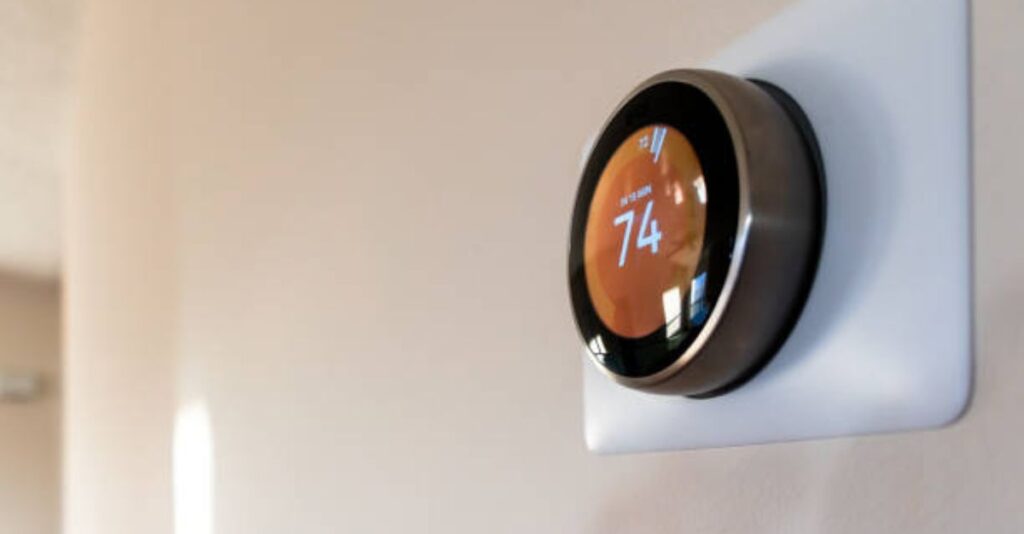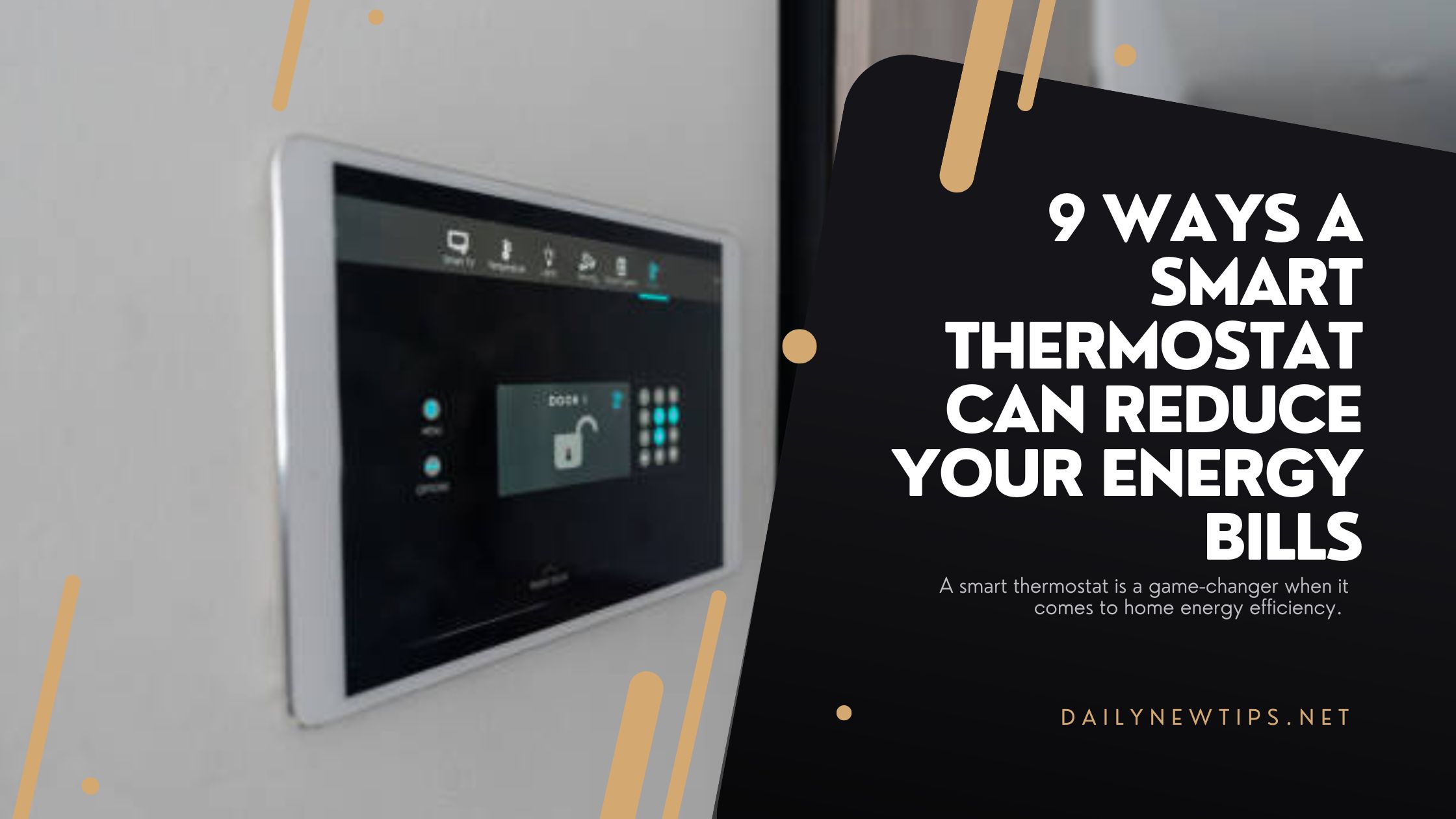Introduction
9 Ways a Smart Thermostat Can Reduce Your Energy Bills
A smart thermostat is a game-changer when it comes to home energy efficiency. By learning your habits, adjusting temperatures automatically, and offering remote control, these devices can significantly lower your energy bills. Here are nine ways a smart thermostat can help you save money..
9 Ways a Smart Thermostat Can Reduce Your Energy Bills

1. Automated Temperature Adjustments
Smart thermostats use sensors and AI to learn your schedule and preferences. They automatically adjust the temperature when you’re away or sleeping, ensuring you don’t waste energy heating or cooling an empty house.
2. Remote Access and Control
With a smart thermostat, you can control your home’s temperature from anywhere using a smartphone app. This means you can adjust settings on the go, preventing unnecessary heating or cooling when no one is home.
3. Energy Usage Reports
Many smart thermostats provide detailed energy reports, helping you track your consumption. These insights allow you to make informed decisions about your heating and cooling habits to optimize efficiency and savings.
4. Smart Scheduling
Instead of relying on manual adjustments, smart thermostats can create customized schedules based on your daily routine. This ensures your home is comfortable when needed and energy-efficient when it’s not.
5. Geofencing Technology
Some smart thermostats use geofencing to detect when you leave or return home. This feature allows the thermostat to adjust the temperature automatically, reducing energy waste when your home is unoccupied.
6. Integration with Smart Home Systems
Smart thermostats integrate seamlessly with other smart home devices, such as voice assistants (Alexa, Google Assistant) and smart sensors. This connectivity enables better automation and efficient energy use.
7. Adaptive Learning Capabilities
Many advanced smart thermostats learn from your behavior over time and adjust temperature settings accordingly. This means they continually optimize heating and cooling to match your lifestyle, reducing energy waste.
8. Weather Adaptation
Some models factor in local weather conditions and adjust your home’s temperature accordingly. For example, if a heatwave is coming, the thermostat can pre-cool your home at a lower cost before peak energy demand hours.
9. Peak Hour Energy Savings
Certain smart thermostats work with utility programs to reduce energy use during peak hours. This helps lower demand on the power grid and can lead to discounts or rebates from your energy provider.
Tips for Maximizing Savings
- Set your thermostat to energy-saving temperatures when you’re asleep or away.
- Regularly update your thermostat’s software to ensure optimal performance.
- Place your thermostat in a central location for accurate temperature readings.
- Use ceiling fans to assist in temperature regulation and reduce HVAC workload.
- Take advantage of eco modes available in most smart thermostats.
Suggestions for Choosing the Right Smart Thermostat
Choosing the right smart thermostat can help you save energy, increase comfort, and provide convenience. Here are some key factors to consider when selecting one for your home:

1. Compatibility with HVAC System
- Ensure the smart thermostat works with your heating and cooling system (e.g., central HVAC, heat pumps, multi-stage systems).
- Check if you need a C-wire (common wire) or if the thermostat has a battery-powered option.
2. Smart Home Integration
- If you use voice assistants like Alexa, Google Assistant, or Apple HomeKit, choose a thermostat that integrates with your smart home ecosystem.
3. Energy-Saving Features
- Look for models with learning capabilities (e.g., Nest Learning Thermostat) that adapt to your schedule and preferences.
- Geofencing technology can adjust the temperature based on whether you’re home or away.
4. Ease of Use & Control Options
- A user-friendly app should allow you to control the thermostat remotely.
- Touchscreen displays or physical buttons should be intuitive for manual adjustments.
5. Scheduling & Automation
- Some models allow for custom scheduling to optimize energy savings.
- AI-powered thermostats learn your habits and adjust automatically.
6. Energy Reports & Insights
- Some thermostats provide energy usage reports to help track and reduce consumption.
- Utility rebates may be available for energy-efficient models.
7. Budget & Price
- Basic models start around $100–$150, while premium models with advanced features range from $200–$300+.
- Consider long-term energy savings when evaluating cost.
8. Brand Reputation & Customer Support
- Popular brands include Google Nest, Ecobee, Honeywell, and Emerson Sensi.
- Read reviews to ensure reliability and good customer service.
Trending Now: Smart Home Energy Efficiency
As smart home technology advances, energy efficiency is becoming a top priority for homeowners. Here are the latest trends in smart home energy management that can help you save money and reduce your carbon footprint.

1. AI-Powered Smart Thermostats
- New models, like the Nest Learning Thermostat and Ecobee Smart Thermostat Premium, use AI and machine learning to adapt to your schedule and optimize heating and cooling.
- Features like geofencing automatically adjust the temperature when you leave or return home.
2. Smart Plugs and Power Strips
- Devices like the Kasa Smart Plug and TP-Link Kasa Smart Power Strip cut energy waste by turning off appliances when not in use.
- Many smart plugs include energy monitoring, helping you track usage in real time.
3. Solar-Powered Smart Homes
- Homeowners are increasingly integrating solar panels with smart energy systems.
- Brands like Tesla Powerwall and Enphase offer battery storage solutions that store excess energy for later use.
4. Smart Lighting Automation
- LED smart bulbs from Philips Hue, LIFX, and Wyze use motion sensors and voice commands to reduce unnecessary energy use.
- Adaptive lighting adjusts brightness based on natural daylight levels.
5. Energy-Efficient Smart Appliances
- ENERGY STAR-rated smart refrigerators, washers, and dishwashers now come with apps that provide insights into energy consumption.
- Smart ovens and microwaves reduce energy use by adjusting cooking times automatically.
6. Home Energy Monitoring Systems
- Devices like the Sense Energy Monitor and Emporia Vue provide real-time data on your home’s energy use.
- They help identify energy-hogging devices and offer suggestions for cutting costs.
7. Smart Water Heaters & Leak Detection
- Wi-Fi-enabled water heaters optimize heating schedules for efficiency.
- Smart leak detectors, like Flo by Moen, prevent water waste and damage by sending alerts to your phone.
8. EV Charging Integration
- More homeowners are installing smart EV chargers like Tesla Wall Connector and ChargePoint Home Flex, which sync with solar panels and off-peak electricity pricing.
9. Government Incentives & Rebates
- Many smart energy devices qualify for rebates and tax credits, making it more affordable to upgrade your home.
- Check local energy programs for savings on smart thermostats, solar panels, and energy-efficient appliances.
By incorporating these smart home energy trends, you can lower your utility bills, increase convenience, and contribute to a more sustainable future.
Conclusion
Investing in a smart thermostat is one of the best ways to cut down on energy costs while maintaining a comfortable home environment. With features like automation, remote control, and energy reports, these devices make it easy to optimize your home’s heating and cooling. If you’re looking for a simple yet effective way to lower your utility bills, a smart thermostat is a worthwhile upgrade.
Frequently Asked Questions (FAQs)
1. How much can a smart thermostat save on energy bills?
A smart thermostat can save between 10% and 20% on heating and cooling costs annually, depending on usage and home insulation.
2. Do smart thermostats work with all HVAC systems?
Not all smart thermostats are compatible with every HVAC system. It’s best to check the specifications before purchasing.
3. Can I install a smart thermostat myself?
Yes, many smart thermostats come with DIY installation guides. However, if you’re unsure, professional installation is recommended.
4. Do smart thermostats work during power outages?
Most smart thermostats retain their settings, but they won’t function without power unless they have a battery backup.
5. Are there any rebates for purchasing a smart thermostat?
Many energy companies offer rebates or incentives for installing a smart thermostat. Check with your local provider for details..
References
- U.S. Department of Energy: Energy-Efficient Thermostats
- Energy Star: Guide to Smart Thermostats
- Consumer Reports: Best Smart Thermostats of the Year

